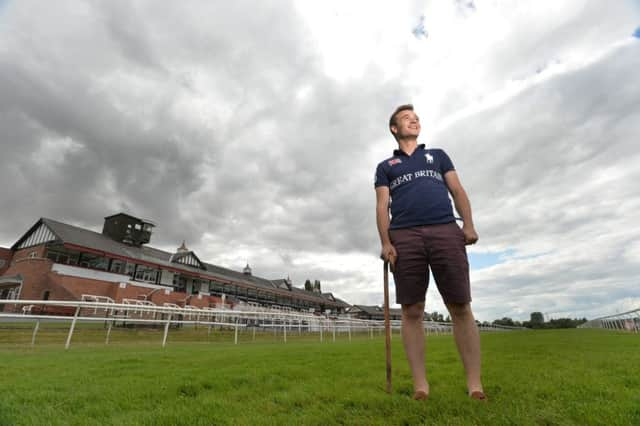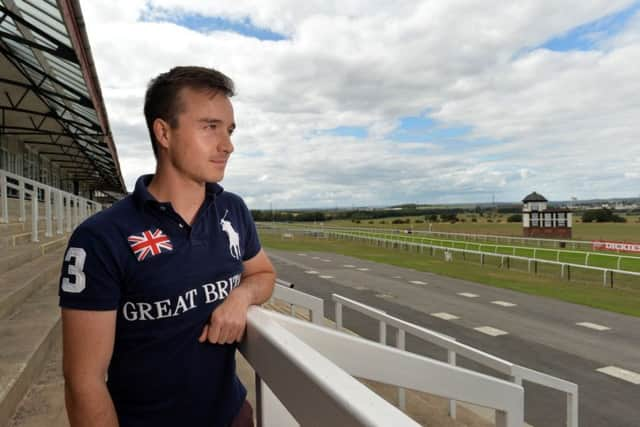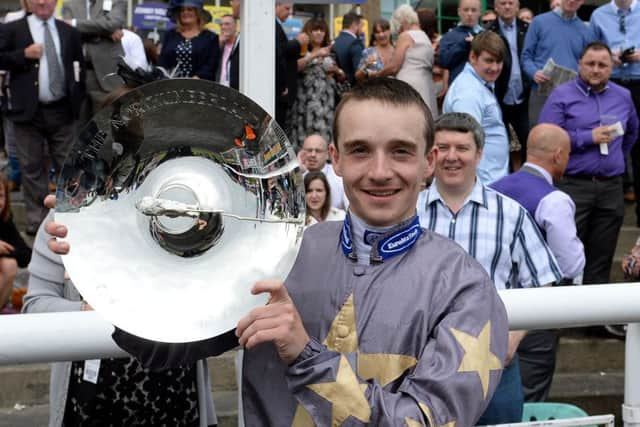How injured jockey George Chaloner is back on track after horror falls that nearly paralysed him


GEORGE Chaloner is used to sleepless nights – the former jockey still endures flashbacks to the horror career-ending fall that nearly paralysed him. Now, as the 26-year-old begins his second career as a trainee clerk of the course, it’s the weather which is more likely to keep him awake.
As the new management assistant at Pontefract, he’s now a fully fledged member of a select team making sure the West Yorkshire track is in perfect condition for horses and spectators. From walking the course each day to offering a jockey’s perspective on the going, and helping with the course’s innovative marketing campaigns, Chaloner has a new racing outlook.
Advertisement
Hide AdAdvertisement
Hide Ad

“The fact you think you know every blade of grass round here and then start this job, you realise you don’t have a ‘scooby doo’ what goes on,” he tells The Yorkshire Post. “You turn up to the races, ride your horse and go home. As soon as one meeting is over, you’re planning for the next.”
Unlike his riding career which was so cruelly cut short by injury, Chaloner has had to hit the ground running as he, and his immediate boss Richard Hamill, prepare to take over the reins when Norman Gundill – Mr Pontefract to many – steps down from clerk of the course at the end of the season.
His first meeting in his new role was called off because of waterlogging and then officials at Pontefract, one of the longest in Europe, have had to contend with drought-like weather. The equivalent of water from seven Olympic-sized swimming pools has been pumped onto two miles of track to ensure that the going didn’t become too quick and pose an unnecessary risk to horse welfare.
No wonder Chaloner’s day begins by walking the entire track with Hamill, and their trusted walking sticks, and ends by studying about six weather apps, and forecasts, to determine if the watering taps need to be turned on.


Advertisement
Hide AdAdvertisement
Hide AdYet, because he rode, he still has the respect of current jockeys and Pontefract hope Chaloner’s input, like where to place running rails to maximise use of the best ground, will lead to better horses competing at the M62 track and, therefore, boost its income. After all, only a rider knows what it’s like to be pitched into the turf form a horse galloping at upwards of 35mph. And, in Chaloner’s painful experience, all too frequently.
Born in Lincoln, Chaloner left school at 16, joined Doncaster’s Northern Racing College and had the good fortune to be offered a placement at the Malton yard of National Hunt trainer Malcolm Jefferson. One of racing’s great gentlemen before he succumbed to cancer in February, Jefferson was a ‘father figure’ to Chaloner and realised that his young apprentice might be better suited to the Flat because of his slight frame.
“He told me one day I would start riding out at Richard Fahey’s, he had sorted it all out for me,” recalls Chaloner. “I used to bike into Malc’s for silly o’clock to muck five out and bike to Fahey’s the other side of town to ride morning work on the gallops. I’d bike back to Malc’s in time to do evening stables. And dinner and bed. That soon got the weight off me to make a go of it on the Flat.”


It worked. The apprentice rider enjoyed his big breakthrough when he won Royal Ascot’s Wokingham Handicap on Fahey’s Baccarat for leading Yorkshire owner Sir Robert Ogden in June 2014. It did not end here. Angel Gabrial’s win two weeks later at Newcastle in the Northumberland Plate, confirmed Chaloner as one of the sport’s brightest prospects.
Advertisement
Hide AdAdvertisement
Hide AdBut in 2015, he suffered a fall on the gallops at trainer Richard Whitaker’s Scarcroft stables. As the horse got to its feet, it stood on the prone rider and left him with a badly broken right foot and ankle. Surgeons had to plate them back together.
Worse came at Wolverhampton the following year when Chaloner’s horse broke its leg on the home bend and pitched the jockey head first into the sand-based surface. “If you hit a golf ball into a bunker, it stops,” he says. “It’s the same with all-weather racing.”
Knocked out, Chaloner was incoherent when he was taken to A&E. Yet, because doctors thought he was inebriated from a stag do as he was still wearing his racing silks, they left him “to sober up”. Only when he got back to York did it emerge that it was more than his pride that was br1oken; his right collarbone needed to be rebuilt with metal plates and another long lay-off ensued.
And after months of torment watching other jockeys win on horses that he would have ridden, Chaloner made his latest comeback at Newcastle on February 1, 2017. It didn’t last one day. His horse, who he described as “the perfect first ride back”, shattered its leg in another tragic misfortune while the jockey broke his back and left foot as he hit the sand.
Advertisement
Hide AdAdvertisement
Hide AdAs he underwent X-rays and emergency care, surgeons spotted six other spinal fractures which Chaloner describes as a legacy of his Wolverhampton fall. “They said I was half a centimetre away from being paralysed and in a chair,” says the jockey, who is all-too-aware that this cruel fate befell one-time champion apprentice Freddie Tylicki. “That was it. I had ridden my last race. At the end of the day, you are only riding a horse around a field.”
Yet he had not. He’d wake in the middle of the night suffering from flashbacks. “I’d be asleep and then wake up in a cold sweat having a panic attack about the Newcastle fall,” he says. “I can’t remember getting on the horse, riding the race. All I remember is the falling part which is probably the worst bit. I couldn’t watch racing for months. I’ve 27 screws in me. I’m worth a fortune in scrap metal. I could talk, and walk the dogs, but racing was all I knew. Terrifying.”
However Chaloner says he’s fortunate to work in a sport that takes pride in how it looks after its own, and praises the Injured Jockey Fund’s Jack Berry House rehab centre at Malton, the Professional Jockeys Association and Jets – the Jockeys’ Education and Training Scheme – for their support. The IJF and PJA arranged for Chaloner to see a psychologist who confirmed he was suffering from a form of post-traumatic stress disorder. He still has fortnightly sessions to help him, while Jets – and friends – helped him put together a CV when the Pontefract job opportunity arose.
He had never done one before. Yet, while nothing will ever replicate the thrill of winning in front of nearly 70,000 spectators at Royal Ascot, he shows a photo on his mobile phone of thousands of people enjoying a post-racing concert at Pontefract. And, at 2am as he left for home, he drew quiet satisfaction from the sea of happy faces. “You look at this and think ‘we’ve done this’,” says Chaloner who started considering his new career after a stint at York’s Ebor festival 12 months ago. “If I didn’t have the support from racing, I don’t know what I’d be doing. I’m still in the industry and have a second career. It’s not a job. It’s a career. I’m the lucky one.”
Advertisement
Hide AdAdvertisement
Hide AdGEORGE Chaloner says awareness of mental health issues in racing now match the care that jockeys receive for physical injuries.
The former jockey, who rode 137 winners on the Flat and who still assists his mentor Malcolm Jefferson’s daughter Ruth at weekends, says this is welcome. “You used to be told to keep your emotions to yourself so not to show weakness. Now more people are talking about mental health and helping others to come to terms with things,” he says. “The racing world is a ‘bubble’. Everyone knows each other. If you don’t know someone, you know someone who does. I was fearful when I effectively retired at 25. Don’t be. The only thing I don’t do is ride a horse. Maybe one day, time is a good healer, but not for now.”